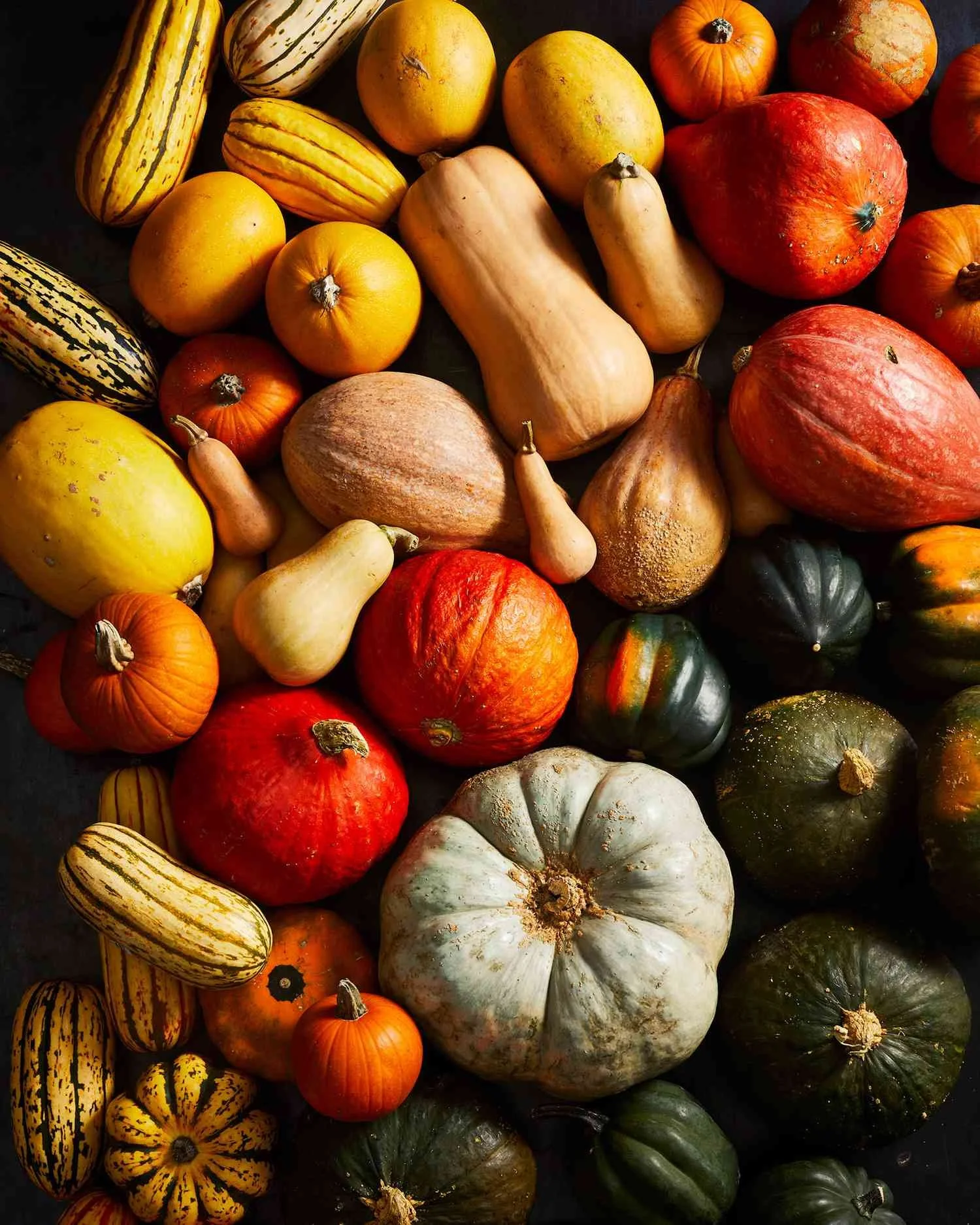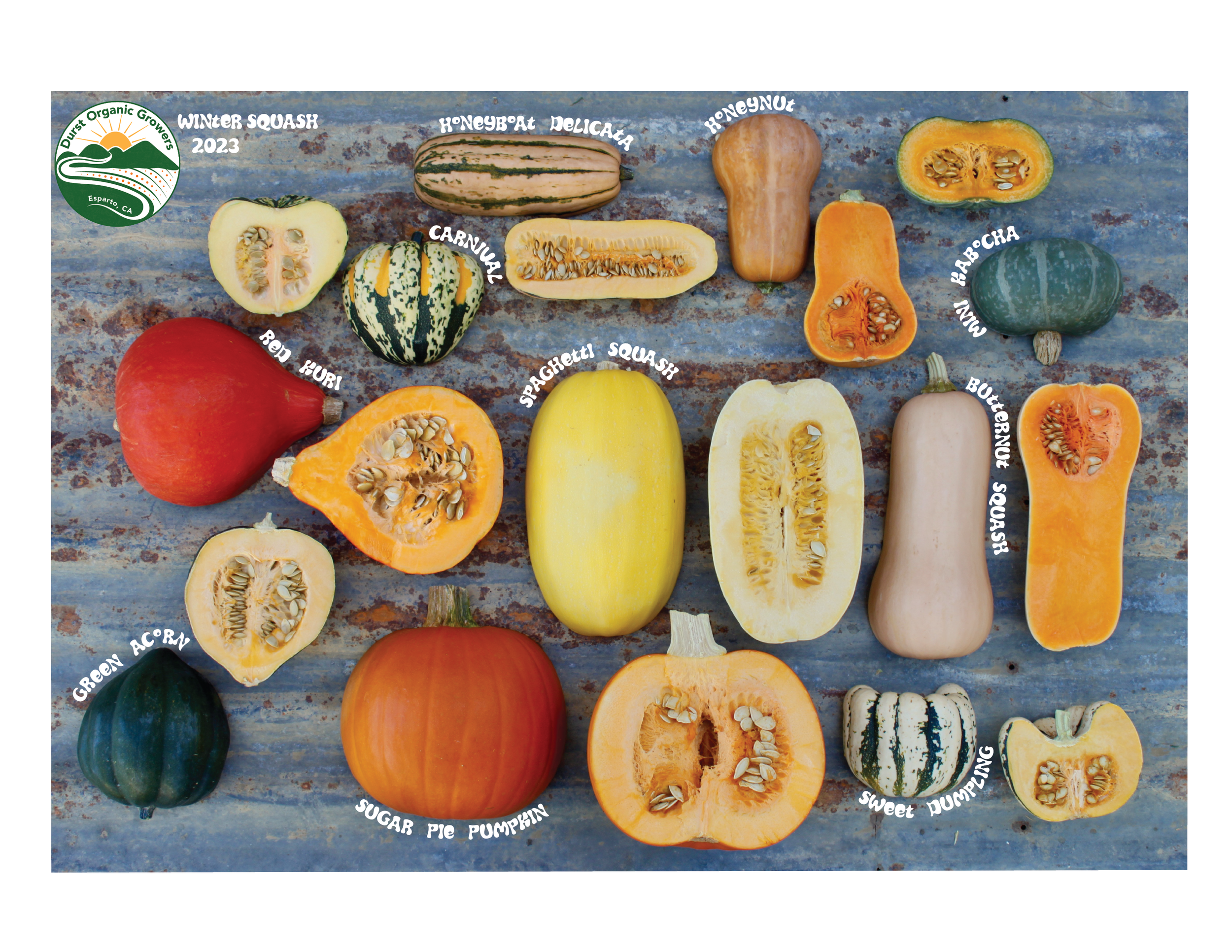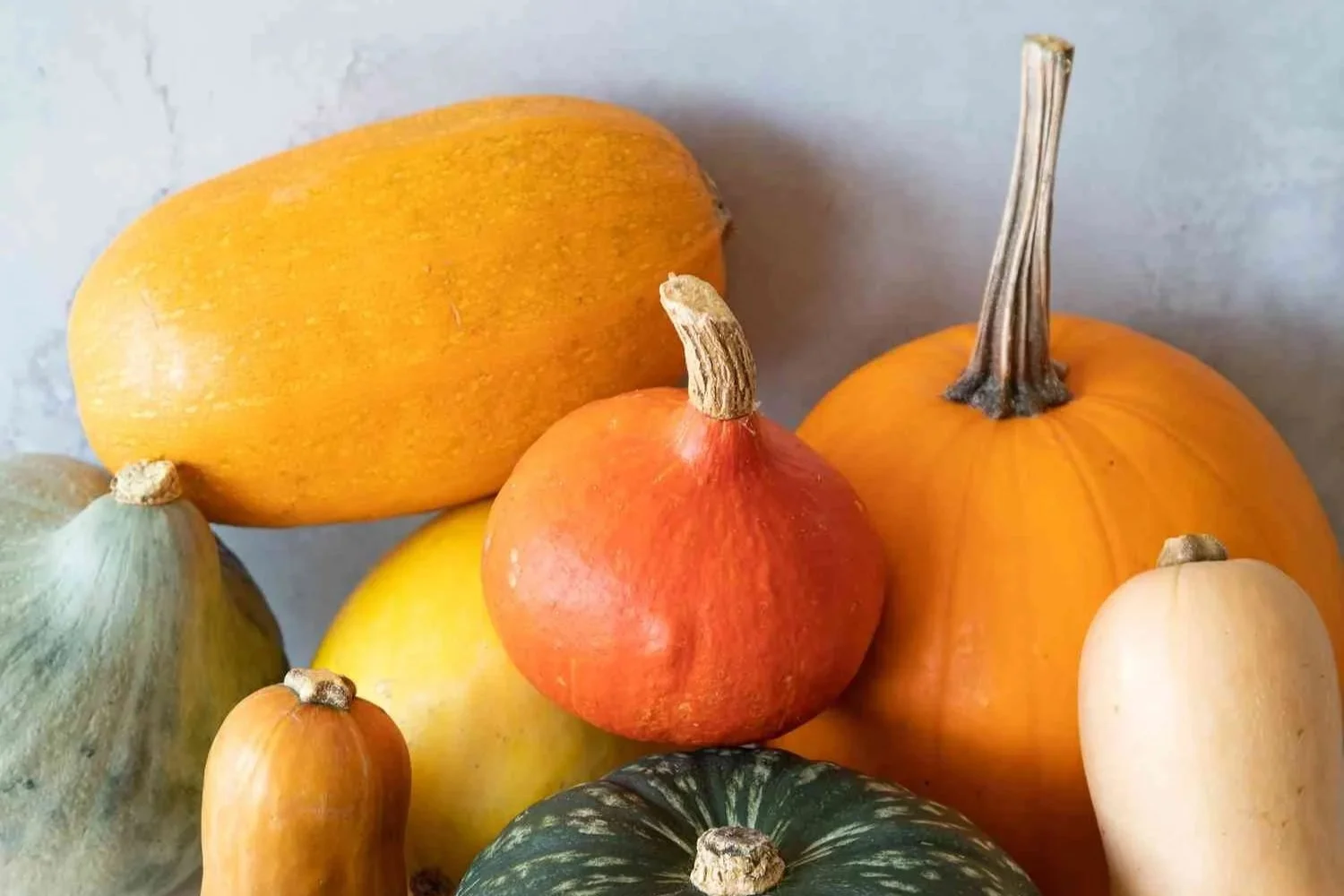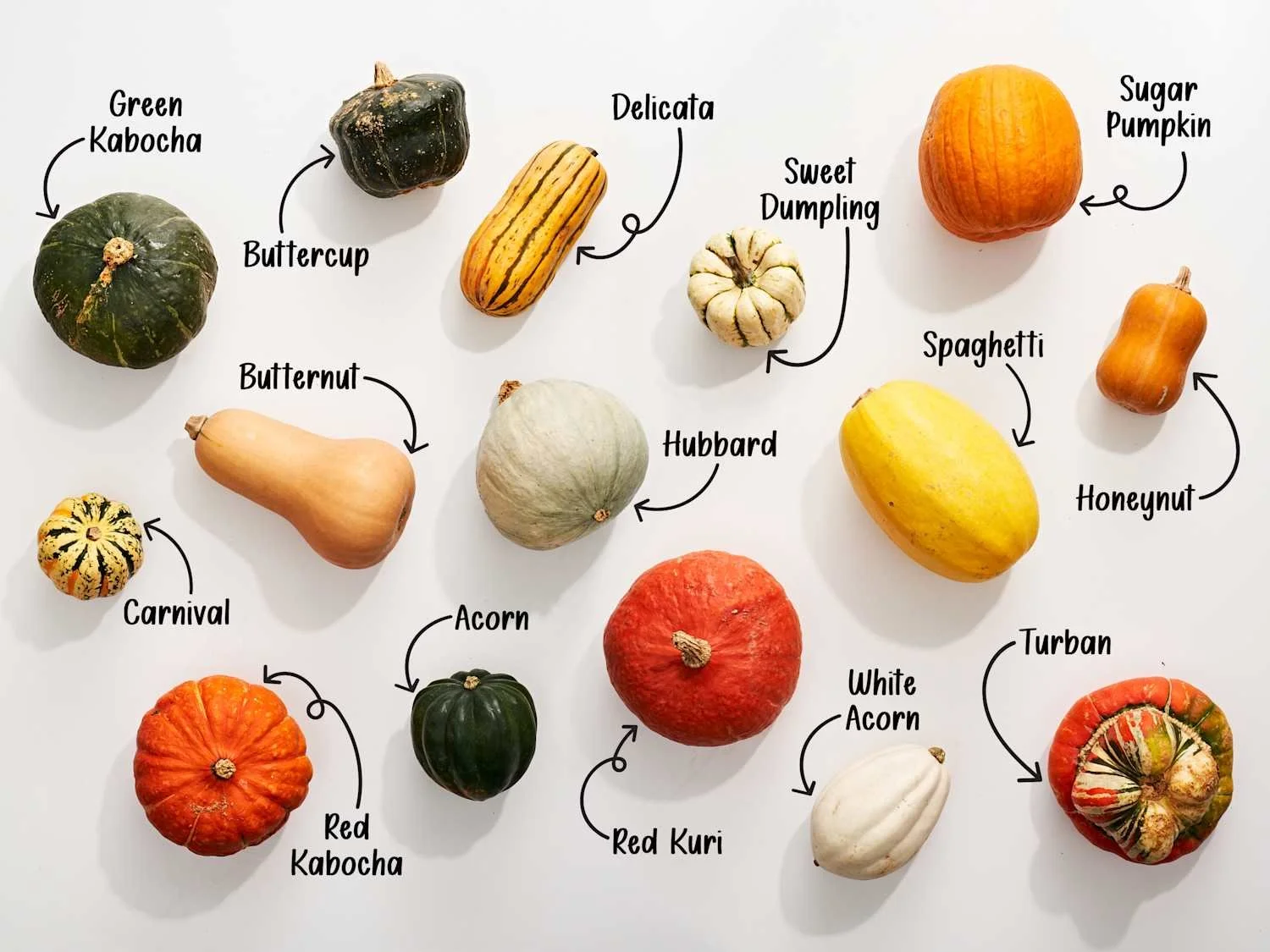The Wonder of Winter Squash
Winter Squash offers a glorious mix of colors, flavors, and culinary versatility—from sweet to savory, and from breakfast to desert.
Exploring History, Diversity & Flavor
As the leaves turn and the air cools, something magical happens in the fields. After a long, hot summer of growth, the vines begin to fade — and in their place, the ground comes alive with color: deep greens, rusty reds, vibrant oranges, moody blues. It's not just fall — it’s winter squash season, and it’s one of our favorite times of the year.
Here at Gateway Farm, we’re endlessly fascinated by the diversity, beauty, and cultural history of winter squash. From sweet dumplings to starry nights, red kuri to honeynut, each squash has its own story — and flavor — to share.
A Brief History of Winter Squash
Winter squash belongs to the Cucurbita genus — the same family as pumpkins, gourds, and zucchini. Archaeological evidence shows that humans have been cultivating squash in the Americas for over 10,000 years.
Squash is one of the original “Three Sisters” — grown alongside corn and beans in Indigenous agriculture to form a balanced, sustainable planting system.
While originally grown for their seeds and sturdy shells, over centuries, farmers and gardeners across the Americas — and later, around the world — began cultivating squash for sweetness, texture, and storage. Today, we benefit from that global heritage with dozens of edible winter squash varieties, each suited for different climates, cuisines, and traditions.
Winter squash was never just about food — it’s about culture, community, and connection to the land.
The Beauty of Diversity: So Many Squash, So Little Time
One of the best parts about growing squash is seeing how incredibly diverse they are — in size, shape, color, and taste. A wide variety of winter squash are grown here in Michigan, from well-known classics to rare heirlooms you won’t find in grocery stores.
Here’s a look at some of the stars of the season:
The Classics:
Butternut – Sweet, smooth, and versatile. A must-have for soups and roasts.
Acorn – Mild and nutty. Great for stuffing and baking.
Delicata – Small, sweet, and striped. No peeling required!
Spaghetti Squash – Mild with stringy flesh. A low-carb pasta alternative.
Specialty Favorites:
Honeynut – A miniature butternut with supercharged sweetness.
Sweet Dumpling – Petite and adorable with creamy, sweet flesh.
Carnival & Starry Night – Beautifully striped acorn hybrids.
Pie Pumpkins – Perfect for baking — rich, smooth, and sweet.
Global Heirlooms:
Red Kuri – A teardrop-shaped Japanese squash with chestnut flavor.
Black Futsu – A bumpy, black-green Japanese variety with edible skin.
Green, Red, & Grey Kabocha – Rich, sweet squashes beloved in Asian cuisine.
Tetsukabuto – “Iron Helmet” squash with ultra-smooth, nutty flavor.
The Showstoppers:
Turban – A wildly decorative squash that looks like it’s wearing a hat.
Blue Hubbard – A massive, warty blue beast with long storage life.
Buttercup – Dense and dry with a signature bottom "cap."
Each of these squash brings something unique — in color, flavor, and cooking style. It's a little like a vegetable treasure hunt, and every fall we get to share that joy with our community.
Cooking & Storage
Winter squash may be intimidating at first (those tough skins! strange shapes!), but with a little prep, they open up a world of possibilities.
Simple Ways to Use Winter Squash
Roasted with olive oil, salt, and herbs
Stuffed with grains, veggies, sausage, or cheese
Blended into creamy soups or sauces
Mashed with butter and maple syrup
Baked into muffins, breads, and pies
Sliced and fried for chips or tempura
Pureed into baby food, sauces, or dips
Tip: Roast a few squash at once, scoop the flesh, and freeze it in portions. It’s perfect for quick meals all winter long.
Storing Winter Squash the Right Way
One of the best things about winter squash is how well it stores — if you treat it right. After harvest, squash needs to be kept dry and cool to extend its shelf life. At home, store your squash in a well-ventilated area out of direct sunlight — like a pantry, basement, or a cool corner of your kitchen. Avoid the refrigerator, as the cold can damage the skin and reduce flavor. Most varieties, like butternut, kabocha, and Hubbard, will last for 2 to 4 months, while smaller types like delicata and sweet dumpling are best enjoyed within a few weeks. Check your squash occasionally for soft spots, and always store them with a bit of space between each to prevent bruising. With proper storage, your Gateway Farm squash can carry you well into winter — bringing a little sunshine to even the coldest Michigan days.
In Praise of Winter Squash
In a world that moves quickly and demands convenience, winter squash invites us to slow down. It asks for a little time and care — and in return, it nourishes deeply. It’s sweet, savory, humble, and beautiful.
And maybe most importantly: it reminds us that the earth still provides, even as the days grow cold.
So next time you're walking through the Farm Stand pause and marvel at the incredible variety of squash — the journey it took to get here, and the meals it will become.
From seed to harvest, from field to table — we’re honored to share this squash season with you.
Winter Squash Guide
There’s a whole world of winter squash beyond just butternut and acorn. Here’s a look at the the classic, heirloom, and specialty varieties you might find.
Butternut
Appearance: Bell-shaped with smooth, pale beige skin and vibrant orange flesh.
Flavor: Sweet, nutty, and smooth — the gold standard of winter squash.
Texture: Creamy when cooked, perfect for purees and soups.
Best Uses:
Roasted in cubes or halves
Blended into soup
Added to risotto, tacos, pasta, or curries
Used in baking (muffins, breads, even pies!)
Farm Tip: Roast extra and freeze it — it keeps beautifully!
Acorn
Appearance: Shaped like an acorn (hence the name), usually deep green with occasional orange blush.
Flavor: Mild, slightly sweet, a bit nutty.
Texture: Soft and tender when roasted, less creamy than butternut.
Best Uses:
Halved and stuffed with grains, sausage, or veggies
Sliced and roasted into crescents
Baked with brown sugar and butter for a classic fall dish
Farm Tip: Eat the skin! It softens when cooked and adds great fiber.
Delicata
Appearance: Long and narrow with cream-colored skin and green stripes.
Flavor: Sweet and nutty — like a cross between sweet potato and corn.
Texture: Smooth and tender, not stringy.
Best Uses:
Sliced into rings or half-moons and roasted
Great for salads, grain bowls, and side dishes
Try roasting with maple syrup and chili flakes!
Farm Tip: The skin is 100% edible — no peeling required.
Spaghetti
Appearance: Oblong, pale yellow skin.
Flavor: Mild and slightly sweet, more about texture than flavor.
Texture: After roasting, the flesh pulls into noodle-like strands.
Best Uses:
Low-carb pasta alternative
Tossed with pesto, marinara, or garlic butter
Great in casseroles and baked dishes
Farm Tip: Roast cut-side down for the best “noodle” texture
Autumn Frost
Appearance: Butternut-shaped with frosty silver-blue blush over orange skin.
Flavor: Smooth, sweet, rich — slightly sweeter than traditional butternut.
Use: Roasting, soups, purées. Very versatile and long-storing.
Fun Fact: A newer hybrid with great shelf life and gorgeous looks.
Sweet Dumpling
Appearance: Small, round, with creamy white skin and deep green stripes.
Flavor: Very sweet, almost chestnut-like.
Use: Perfect for roasting whole or halved and stuffing. Great for single servings.
Fun Fact: Small size makes it ideal for individual plates or market snacks.
Red Kabocha (aka “Sunshine Kabocha”)
Appearance: Bright red-orange skin with squat, round shape.
Flavor: Deeply sweet, dense, and rich — similar to sweet potato.
Use: Best for soups, curries, and roasting. A favorite in Japanese and Thai cooking.
Fun Fact: Red kabocha is sweeter than many other squashes — it's dessert-level sweet!
Grey Kabocha
Appearance: Pale gray-green skin, round, often with a flattened top.
Flavor: Sweet, nutty, and dry-textured.
Use: Roasting, mashing, tempura, and even baking.
Fun Fact: Stores incredibly well and is prized in Asian cuisine.
Green Kabocha
Appearance: Deep forest green skin, often with faint stripes.
Flavor: Dense, rich, sweet, and buttery.
Use: Excellent for roasting, soups, or even pies.
Fun Fact: One of the most popular squashes in Japan, known as kabocha there.
Blue Hubbard
Appearance: Large, bumpy, dusty blue-gray skin — sometimes huge!
Flavor: Smooth, sweet, and dense.
Use: Ideal for pies, purées, and big-batch cooking.
Fun Fact: These giants are known for long shelf life — up to 6 months when stored properly.
Carnival
Appearance: Colorful mix of green, orange, and yellow stripes over acorn shape.
Flavor: Mildly sweet and nutty.
Use: Roasting, baking, or stuffing. Decorative AND delicious.
Fun Fact: A cross between sweet dumpling and acorn squash.
Starry Night
Appearance: A gorgeous, speckled version of acorn squash — green with yellow star-like flecks.
Flavor: Mild, slightly sweet, more savory than sweet dumpling.
Use: Roasting, stuffing, and beautiful in displays.
Fun Fact: Named for its Van Gogh-esque appearance.
Pie Pumpkins (a.k.a. Sugar Pumpkins)
Appearance: Small, round, deep orange.
Flavor: Smooth, sweet, and not stringy like carving pumpkins.
Use: The best for pies, custards, and baked goods.
Fun Fact: If you’ve only used canned pumpkin, try roasting your own — the flavor is unbeatable.
Red Kuri (a.k.a. Hokkaido Squash)
Appearance: Teardrop-shaped, reddish-orange skin, no ridges.
Flavor: Sweet, creamy, and nutty — with a hint of chestnut.
Use: Great for soups, risottos, and roasting. Skin is thin and edible.
Fun Fact: A French favorite, known as Potimarron in Europe.
Buttercup
Appearance: Round, dark green with a distinctive gray “button” on the bottom.
Flavor: Very sweet, creamy, and dry.
Use: Soups, roasting, casseroles.
Fun Fact: Often confused with kabocha but typically a bit drier in texture.
Turban
Appearance: Wild, colorful shape with a bulbous cap — looks like a turban.
Flavor: Mild and nutty with hints of hazelnut.
Use: Beautiful for stuffing and table displays. Edible and ornamental!
Fun Fact: The original “centerpiece squash” — edible art!
Black Futsu
Appearance: Deep green-black skin with heavy ribbing that matures to dusty orange.
Flavor: Rich, earthy, nutty — develops complex flavor after curing.
Use: Great for roasting, tempura, and decorative displays.
Fun Fact: A rare Japanese heirloom prized for flavor and appearance.
Tetsukabuto
Appearance: Round, dark green, smooth skin. Often slightly flattened.
Flavor: Incredibly rich and dense — a blend of kabocha and buttercup traits.
Use: Excellent in curries, baking, or savory dishes.
Fun Fact: A Japanese hybrid squash whose name means “Iron Helmet” — it’s tough on the outside but sweet on the insid
Honeynut Squash
Appearance: Like a mini butternut squash — small, cute, and deeply orange with smooth skin that darkens as it ripens.
Flavor: Intensely sweet, rich, and slightly nutty — sweeter than regular butternut, with deep caramel notes.
Texture: Creamy and smooth when roasted.
Best Uses:
Simply halved and roasted — it barely needs seasoning!
Mashed or puréed for soups
Sliced and pan-roasted for salads or grain bowls
Great for roasting whole and serving as a side
Farm Tip: The skin is thin and tender — you can eat it!
Fun Fact: Honeynut was developed by plant breeders to pack more flavor and nutrition into a smaller squash. It has 2–3x more beta carotene than butternut!





